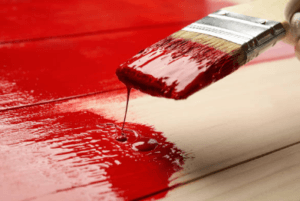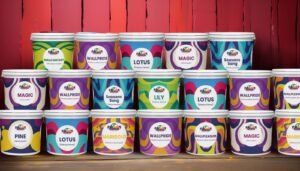Introduction to Solvent-Based Paint
Solvent-based paint is a type of coating that utilizes solvents to dissolve the resins and pigments, leading to a homogenous mixture that can be easily applied to various surfaces. The primary components of this paint include binders, pigments, and solvents, each playing a vital role in the overall performance and characteristics of the product. Binders are responsible for adhering the pigments to the substrate, while pigments provide color and opacity. Solvents, on the other hand, are volatile organic compounds (VOCs) that evaporate as the paint dries, allowing the binder to form a solid film.
One of the defining characteristics of solvent-based paint is its durability. These paints are typically more resistant to wear, weather, and various chemicals compared to their water-based counterparts. The evaporation of solvents enables a faster drying process, which can be advantageous in time-sensitive applications. However, the use of VOCs raises environmental and health concerns, prompting a shift towards low-VOC and eco-friendly alternatives. Despite this trend, solvent-based options remain popular, especially in industries that require robust finishes, such as automotive and manufacturing.
The chemistry behind solvent-based paints involves a delicate balance between the constituents. The solvent’s role is not only to aid application but also to influence factors such as viscosity and flow. When applied, the solvent evaporates, allowing the paint to adhere to the surface effectively. As the solvent dissipates, the film hardens, creating a durable and water-resistant layer. Understanding these chemical interactions is essential for proper application and achieving the desired finish. Ultimately, knowledge of solvent-based paint can help professionals make informed choices regarding its usage in various projects, balancing performance and environmental considerations.

Types of Solvents based paint Used
Solvent-based paint formulations are characterized by their composition and the specific solvents utilized within them. Among the most commonly employed solvents are mineral spirits, turpentine, and various ketones, each providing unique properties that influence the performance of the paint.
Mineral spirits, also known as white spirits, are derived from petroleum refining. This solvent is frequently used in solvent-based paint because it effectively dissolves the paint pigments, ensuring even distribution and a smooth application. One of the primary benefits of mineral spirits is their relatively low toxicity compared to other solvents. However, they can emit strong vapors that necessitate proper ventilation during use. Their slow evaporation rate makes them suitable for prolonged work times, particularly for larger projects.
Turpentine is another traditional solvent, sourced from the resin of pine trees. Known for its strong solvent properties, turpentine facilitates quick drying of oil-based paints. The robust characteristics of this solvent allow it to dissolve a wide range of paint components effectively. However, turpentine is more pungent than mineral spirits, which may present challenges regarding user comfort. Additionally, turpentine can be irritating to the skin and respiratory system, necessitating careful handling and the use of protective gear.
Ketones, such as acetone, are also used in some solvent-based paints, particularly for formulations needing rapid drying times. Acetone is a highly efficient solvent that can dissolve many types of resins and other paint components. Its quick evaporation rate aids in achieving shorter drying periods. However, it can be harsh on certain surfaces and may not be suitable for all applications. The use of ketones may also require consideration of their strong odor and potential health impacts.
In conclusion, each type of solvent plays a vital role in determining the effectiveness and characteristics of solvent-based paint. By understanding the properties, benefits, and drawbacks associated with these solvents, users can make informed decisions that enhance their painting projects and ensure satisfactory results.

Advantages of Solvent-Based Paint
Solvent-based paint has become a popular choice among both professional painters and DIY enthusiasts due to its numerous advantages. One of the most significant benefits is its durability. Unlike water-based paints, solvent-based alternatives tend to create a tougher finish, providing better wear resistance. This characteristic makes them particularly suitable for high-traffic areas or surfaces that are exposed to harsh elements. The attribute of longevity is essential for any paint, as it reduces the frequency of repainting, thereby resulting in long-term cost savings.
Another major advantage of solvent-based paint is the ease of application. When applied correctly, solvent-based paints tend to flow better, allowing for smoother finishes with fewer brush strokes or roller marks. This property enables even novices to achieve professional-looking results with relative ease. Additionally, solvent-based paints dry at a quicker pace, facilitating faster project completion, which is particularly beneficial for contractors working on tight schedules.
Resistance to environmental factors is another compelling feature of solvent-based paints. They are intrinsically less affected by moisture and temperature fluctuations, making them an ideal choice for outdoor applications. This resistance ensures that surfaces maintain their integrity even when faced with adverse weather conditions. Aesthetically, solvent-based paints offer a plethora of finish options. From high-gloss to satin finishes, these paints provide versatility for various design preferences. Furthermore, they boast superior color retention, ensuring that the vibrancy of the applied color lasts longer without fading.
In conclusion, the advantages of solvent-based paint include remarkable durability, user-friendly application, and effective resistance to environmental elements. Its aesthetic benefits, combined with long-lasting performance, make it a practical choice for diverse painting projects.

Disadvantages and Safety Concerns
Solvent-based paints, while widely used for their durability and finish quality, come with a range of notable disadvantages and safety concerns. One of the primary health risks associated with these paints is the potential for inhalation of toxic fumes. The solvents found in these products can release volatile organic compounds (VOCs) that may lead to respiratory issues, headaches, and other acute effects upon prolonged exposure. Users and workers must recognize the necessity of adequate ventilation when applying these types of paints to safeguard their health.
In addition to respiratory concerns, solvent-based paints can also pose risks through skin contact. The chemicals in these paints can cause skin irritation or allergic reactions, making it imperative for individuals applying them to wear appropriate protective gear, such as gloves and long-sleeved clothing. These safety measures become even more crucial for those who are regularly exposed to such materials, emphasizing the importance of a responsible approach to application and handling.
Another critical disadvantage is the flammability of solvent-based paints. The solvents used can ignite easily, creating hazardous situations when sparks or open flames are present. Therefore, it is crucial that applications take place away from any ignition sources, and that all materials are stored and disposed of according to safety guidelines. Worker safety can be significantly enhanced by understanding the characteristics and behavior of the products being used.
Moreover, the environmental impact of solvent-based paints cannot be overlooked. The release of VOCs contributes to air pollution and can harm ecosystems if not managed correctly. The accumulation of these substances in landfills further exacerbates their environmental footprint. Given these significant concerns, it is necessary for users to be informed and prepared, implementing all safety precautions while also exploring alternatives like water-based paints when feasible.
Application Techniques and Best Practices
When working with solvent-based paint, selecting the appropriate application technique is crucial for achieving the desired results. The primary tools used in the application of these paints include brushes, rollers, and sprayers. Each tool offers distinct advantages and is suited for specific applications. For instance, brushes are ideal for precise work and touching up corners or intricate details, while rollers provide an efficient means of covering large surfaces. Sprayers, on the other hand, allow for a smooth and even finish, making them particularly useful for expansive areas with minimal interruption.
Prior to application, thorough surface preparation is critical. This involves cleaning the surface to remove dust, grease, and other contaminants that could affect adhesion. In some cases, it may also be beneficial to sand the surface to create a better bond with the mithila paint. Ensuring the surface is dry and free from imperfections is integral to achieving a flawless outcome. Proper preparation not only enhances the appearance of the paint but also extends its durability.
For optimal results, it is advisable to apply solvent-based paint in thin layers rather than one thick application. Thin layers allow for quicker drying times and significantly reduce the risk of drips or uneven finishes. Generally, applying multiple coats, with appropriate drying times in between, leads to a deeper color and a more resilient finish. It is essential to consult the manufacturer’s instructions regarding specific drying times, as these can vary based on the formulation of the paint and environmental conditions.
By selecting the appropriate tools, adequately preparing the surface, and applying the mithila paint in thin layers, one can achieve a professional finish that meets both aesthetic and functional requirements. Adhering to these best practices is essential in ensuring the longevity and visual appeal of the painted surface.

Comparison with Water-Based Paint
When considering the right type of paint for a project, understanding the differences between solvent-based and water-based paints is crucial. Solvent-based paints are known for their durability and resistance to wear and environmental factors. They often provide a robust finish that can be ideal for surfaces exposed to moisture or heavy use, such as woodwork, metal, and outdoor applications. Their ability to dry quickly can be advantageous in professional settings where time is a limiting factor. In contrast, water-based paints are generally easier to work with, have lower levels of volatile organic compounds (VOCs), and offer a more user-friendly cleanup process, as they can often be diluted or cleaned with water.
Performance is a key factor in this comparison. Solvent-based paints typically form a harder, more durable surface compared to their water-based counterparts. This can be particularly beneficial for high-traffic areas or surfaces that are likely to experience significant wear. However, this durability often comes at a cost; solvent-based paints may contain high levels of VOCs, which can contribute to air pollution and pose health risks if proper safety measures are not observed. On the other hand, water-based paints generally emit fewer VOCs, making them a more environmentally friendly option and suitable for indoor applications where air quality is a priority.
Cost is another significant consideration when choosing between these two types of paints. Solvent-based paints can be more expensive due to their complexity and formulation, while water-based paints often offer a more budget-friendly alternative that provides adequate performance for many standard applications. The choice between solvent-based and water-based paints ultimately depends on the specific requirements of the project, such as surface type, desired finish quality, and environmental considerations. Choosing the right type can enhance the longevity and appearance of the project while also ensuring compliance with health and safety standards.

Common Uses of Solvent-Based Paint
Solvent-based paint has established itself as a versatile choice across various industries due to its unique properties, which cater to specific environmental needs. One of the primary sectors that utilize solvent-based paint is the automotive industry. These paints are preferred for automobile finishes due to their durability and resistance to chemicals, weathering, and surface abrasions. Manufacturers often opt for solvent-based options because they effectively provide a smooth, glossy finish that enhances the aesthetic appeal of vehicles while ensuring long-lasting protection.
In addition to the automotive sector, solvent-based paints are widely employed in the furniture industry. The unique capabilities of these paints allow for better adhesion and long-lasting performance, making them ideal for wooden furniture that undergoes frequent use. Solvent-based formulations can penetrate wood surfaces more effectively than their water-based counterparts, resulting in a robust, durable finish that resists scratches and stains. This makes them a preferred choice for high-end furniture pieces that require a polished look and lasting protection against wear and tear.
The home improvement sector also extensively utilizes solvent-based paint, especially for exterior applications. The environmental factors, such as moisture and sunlight exposure, significantly affect the longevity of paints. Solvent-based options are well-regarded for their resilience in these challenging conditions. Homeowners often choose solvent-based paints for exterior walls, railings, and shutters, as they provide excellent coverage and minimal maintenance requirements over time. Moreover, the rapid drying time inherent to these paints allows for quicker project turnaround, enhancing their appeal in DIY projects.
In conclusion, the unique properties of solvent-based paint render them valuable to several industries, including automotive, furniture manufacturing, and home improvement. Their durability, resistance to adverse conditions, and appealing finish contribute to their popularity and effectiveness in various applications.
Regulatory Issues and Environmental Considerations
The use of solvent-based paints is subject to a complex regulatory framework designed to mitigate their environmental impact. One prominent area of focus is the regulation of volatile organic compounds (VOCs), which are harmful emissions that can arise during the application and drying of these paints. Authorities in various regions have established stringent limits on the amount of VOCs permitted in solvent-based formulations. Compliance with these regulations is not only a legal obligation for manufacturers but also a critical aspect of promoting public health and environmental sustainability.
In response to these regulations, many paint manufacturers have invested in research and development aimed at reducing VOC levels in their products. Innovations such as water-based formulations and high-performance latex alternatives have gained traction as suitable substitutes for traditional solvent-based paints. These alternatives typically release fewer harmful emissions and are easier to clean up, further enhancing safety during application. The ongoing development in this space reflects a growing awareness of environmental considerations within the paint industry.
Moreover, regulatory entities often encourage the adoption of best practices in the application of solvent-based paints to minimize potential hazards. This includes guidance on using protective gear, ensuring proper ventilation, and following recommended drying times. Such measures are essential not only for protecting the environment but also for safeguarding the health of individuals involved in painting projects. The integration of innovative technologies, such as low-VOC and zero-VOC paints, is becoming increasingly common as manufacturers seek to comply with regulatory expectations while also meeting consumer demand for greener solutions.
Ultimately, the landscape surrounding solvent-based paints is evolving in response to heightened environmental awareness and regulatory directives. While these paints remain integral to many industries, including arts and crafts, the sector is moving towards a more sustainable future, fostering practices that prioritize both performance and ecological responsibility.
Future Trends in Solvent-Based Paints
The landscape of solvent-based paints is evolving due to an increasing demand for sustainability and safety in formulation. Manufacturers are focusing on developing less harmful solvents, which could significantly reduce the health and environmental risks associated with traditional solvent-based paints. This shift is largely driven by stricter regulations aimed at minimizing volatile organic compounds (VOCs) that are typically found in many solvent-based products. The new formulations prioritize not only the effectiveness of the paint but also an eco-friendly footprint, presenting a healthier alternative for consumers and professionals alike.
In addition to adopting safer solvents, the industry is witnessing the emergence of innovative eco-friendly alternatives. Waterborne paint systems are gaining popularity as they offer reduced VOC levels while maintaining the high-performance characteristics typically associated with solvent-based paints. These systems are formulated to provide excellent adhesion, durability, and finish quality, appealing to environmentally conscious consumers without compromising on the traditional benefits that solvent-based options have long provided.
Furthermore, advancements in technology are leading to innovations in solvent-based formulations. Research is being conducted to enhance the performance of these paints by improving their weather resistance, color retention, and application qualities. For example, new additives and binders are being explored to optimize flow and leveling, thereby ensuring a smoother application even under less-than-ideal conditions. This not only saves time but also reduces the need for multiple coats, making the process more efficient for users.
As the industry continues to adapt and innovate, the future of solvent-based paints looks promising. A balanced approach that respects environmental regulations while delivering premium quality will likely redefine the standards of painting, harmonizing both the ecological and functional aspects of these essential materials.


